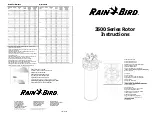
UltiMate 3000 Series:
SR-3000 Solvent Rack
Page
4
Operating Instructions
•
Electrostatic discharge
Discharge of electrostatic energy may lead to sparking and can constitute a fire hazard.
Keep in mind that liquid flowing through capillaries can generate static electricity. This
effect is particularly pronounced in insulating capillaries and with non-conductive
solvents (for example, pure acetonitrile).
Take appropriate measures to prevent the generation of static electricity near the HPLC
system. For example, make sure that the air humidity level in the laboratory is
sufficiently high and provide proper ventilation, wear anti-static clothing or shoes,
prevent accumulation of air bubbles in waste lines, and use grounded waste containers.
Use only non-conductive capillaries to direct solvents into the waste container. With
electrically conductive capillaries, make sure that they are properly grounded.
•
Self-ignition of solvents
Do not use solvents for which the self-ignition temperature is below 150 °C. In case of
leakage, these solvents may self-ignite on a hot surface.
•
Capillaries, capillary connections, open connections
♦
Capillaries, especially non-metallic capillaries may burst, slip out of their fittings or
may not be screwed in. This may result in substances spraying out of the open
connections.
♦
In an UltiMate 3000 system, some components are made of PEEK™. This polymer
has superb chemical resistance to most organic solvents. However, it tends to swell
when in contact with trichlormethane (CHCl
3
), dimethyl sulfoxide (DMSO), or
tetrahydrofuran (THF). In addition, it is attacked by concentrated acids, such as,
sulfuric acid and nitric acid or a mixture of hexane, ethyl acetate, and methanol. In
both cases, capillaries may start leaking or they can burst. Swelling or attack by
concentrated acids is not a problem with brief flushing procedures.
♦
Do not use tubing that is stressed, bent, kinked, or damaged.
♦
Capillary connections can be contaminated by harmful substances or harmful
substances can escape from open connections.
♦
Some capillaries of the RS pumps and some Viper system capillaries are made of
MP35N
®
, a nickel-cobalt based alloy. Individuals with sensitivity to nickel/cobalt may
show an allergic reaction from skin contact.
♦
Always wear safety glasses when handling fused silica tubing, for example, during
installation or when cutting capillaries to the length.
•
For safety reasons, you shall not lift the SRD with one or more solvent reservoirs being in
the tray.
•
Use only the original spare parts and accessories authorized for the device by Thermo
Fisher Scientific.
Summary of Contents for SR-3000
Page 2: ...UltiMate 3000 Series SR 3000 Solvent Rack Operating Instructions ...
Page 4: ...UltiMate 3000 Series SR 3000 Solvent Rack Page II Operating Instructions ...
Page 6: ...UltiMate 3000 Series SR 3000 Solvent Rack Page ii Operating Instructions ...
Page 16: ...UltiMate 3000 Series SR 3000 Solvent Rack Page 10 Operating Instructions ...
Page 24: ...UltiMate 3000 Series SR 3000 Solvent Rack Page 18 Operating Instructions ...
Page 26: ...UltiMate 3000 Series SR 3000 Solvent Rack Page 20 Operating Instructions ...











































